
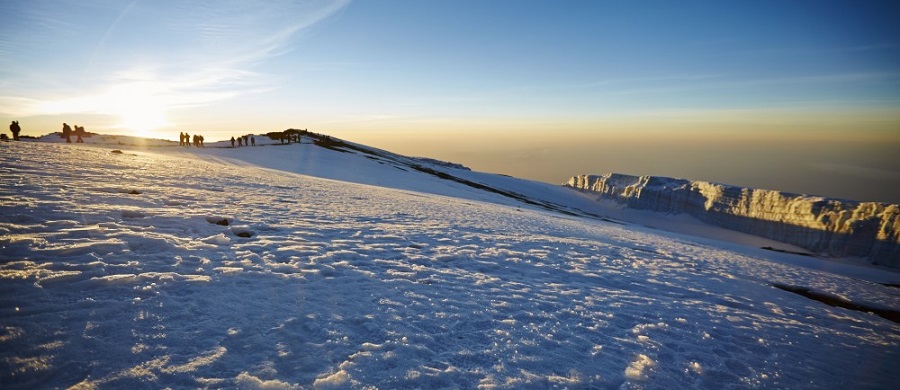
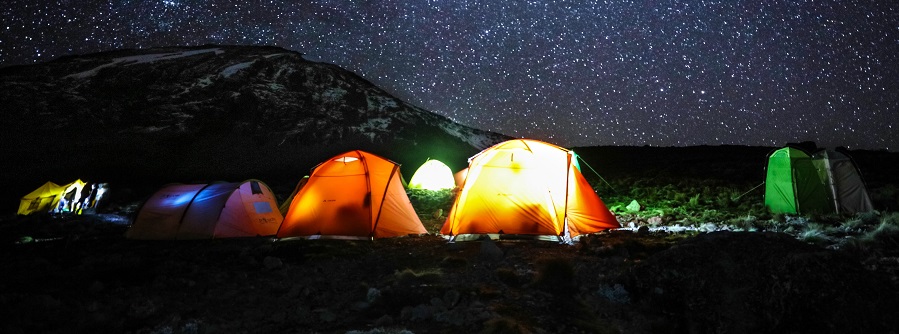
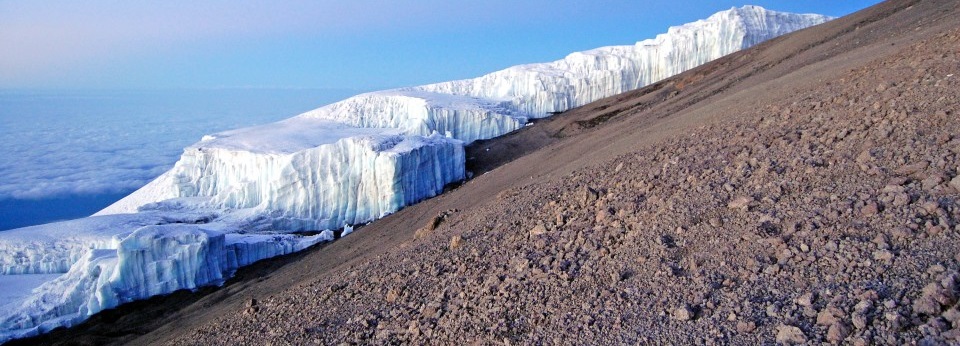
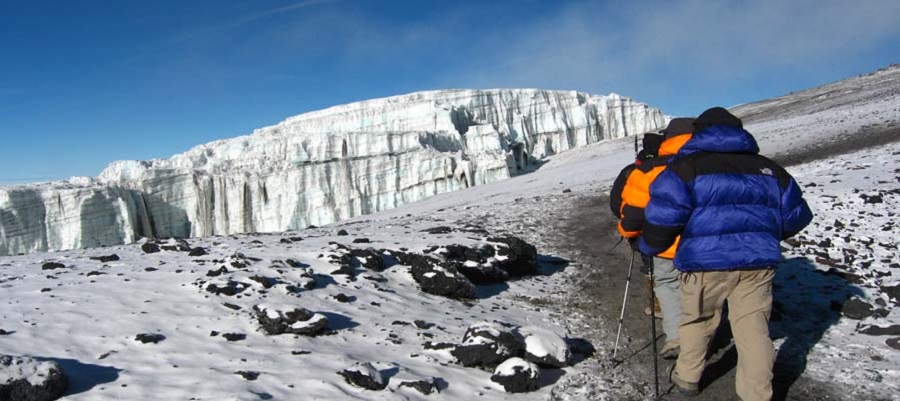
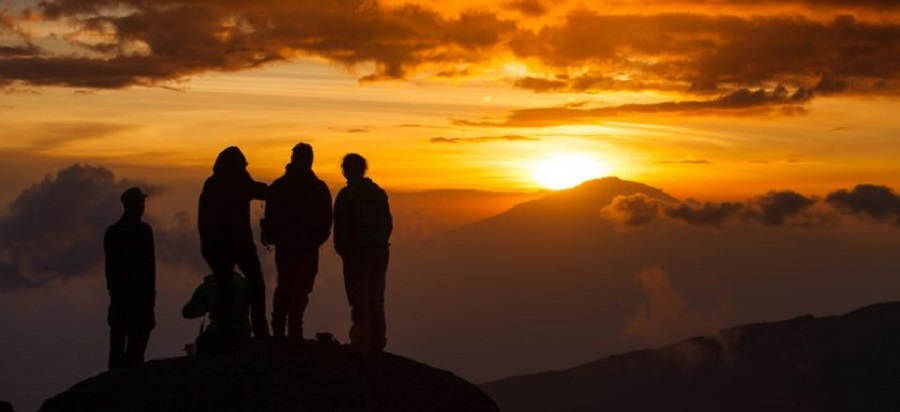
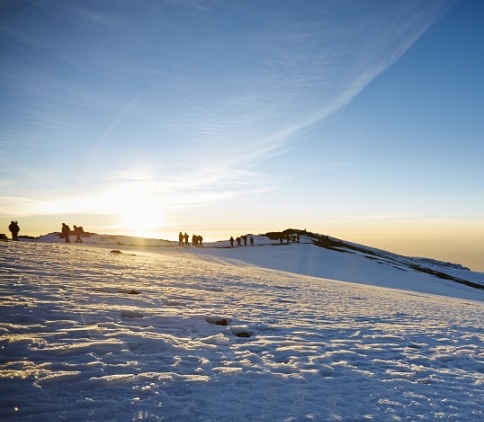
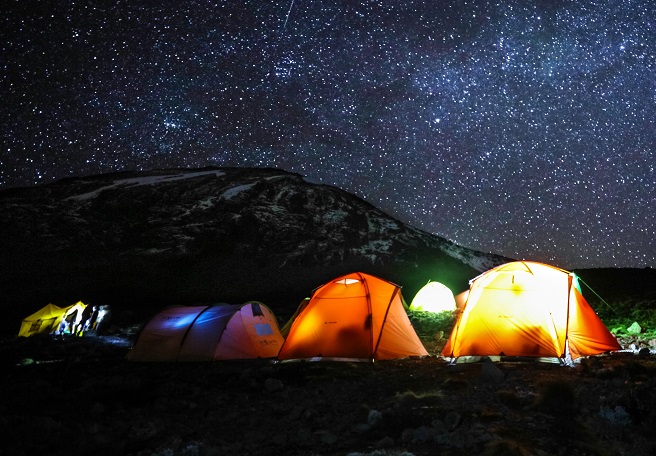
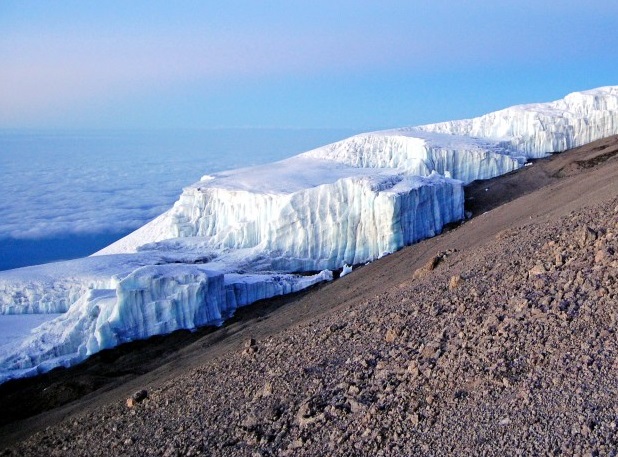
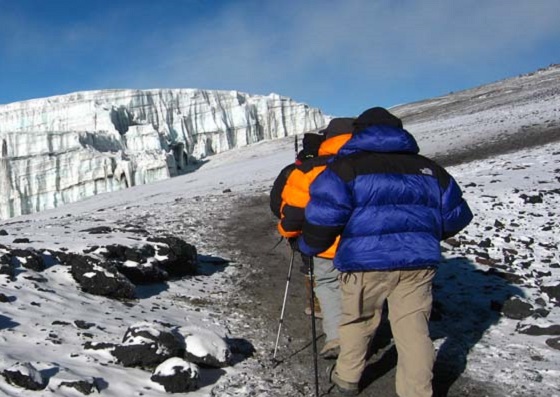
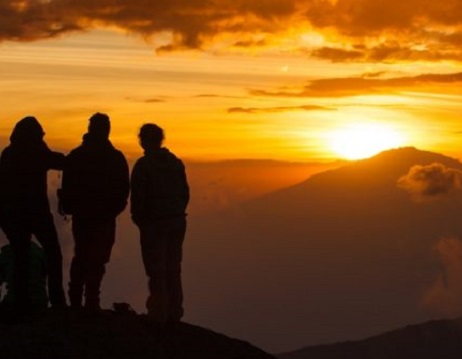
Bekend als de "Coca-Cola" -route, is de Marangu-route een klassieke trektocht op de Kilimanjaro. Het is de oudste, meest bekende route. Velen geven de voorkeur aan de Marangu-route, omdat deze als het gemakkelijkste pad op de berg wordt beschouwd, gezien de geleidelijke helling. Het is ook de enige route die slaaphutten biedt in accommodaties in slaapzalen. De minimaal vereiste dagen voor deze route zijn vijf. Marangu wordt vooral begunstigd tijdens het regenseizoen, waar de hutaccommodaties de voorkeur hebben boven natte grond. De Marangu-route, bekend als de "Coca-Cola" -route, nadert de Kilimanjaro vanuit het zuidoosten. Het is de oudste, meest bekende route. Velen geven de voorkeur aan de Marangu-route omdat deze als het gemakkelijkste pad op de berg wordt beschouwd, gezien de geleidelijke helling en het directe pad.
De Marangu Route is een van de meest populaire trektochtroutes op de Kilimanjaro in Tanzania. Deze route biedt gedurende zes dagen een relatief comfortabele beklimming met slaaphutten langs de weg. De reis begint bij de Marangu Gate en stijgt geleidelijk door weelderige regenwouden, met prachtige uitzichten op de diverse flora en fauna van de Kilimanjaro. Hoogtepunten zijn onder andere het doorkruisen van het alpine woestijnlandschap en het bereiken van de top op Uhuru Peak, het hoogste punt van Afrika. Langs de route ervaren trekkers verschillende klimaatzones, van tropisch tot arctisch, waardoor het een uniek en onvergetelijk avontuur is. De Marangu Route wordt vaak gekozen vanwege de lichte hellingen en consistente terrein, waardoor het geschikt is voor mensen die een minder inspannende maar toch belonende Kilimanjaro-ervaring zoeken.
De Marangu-route, ook bekend als de "Coca-Cola"-route, is een 6-daagse trektocht naar de top van de Kilimanjaro die door sommigen wordt beschouwd als de makkelijkste route op de berg. De route is populair omdat deze in minder dagen kan worden voltooid en permanente slaaphutten heeft op de kampeerplaatsen. De route is ook de oudste en meest gevestigde op de Kilimanjaro, en de enige route die slaaphutten biedt in slaapzaalstijl accommodaties.
Hoe boek je een 6-daagse Kilimanjaro beklimming via de Marangu-route?
De beste manier om de beste 6-daagse Kilimanjaro beklimming via de Marangu-route te boeken, is door ons een e-mail te sturen via africanaturaltour2008@gmail.com of bel ons rechtstreeks op WhatsApp op +255 764 415 889 om safari-reserveringen te maken. Dit gedetailleerde reisschema biedt een uitgebreide verkenning van de 6-daagse Kilimanjaro beklimming via de Marangu-route en natuurwonderen, zodat je een onvergetelijke wandelervaring hebt voor het hele gezin. We accepteren betalingen in Amerikaanse dollars, ponden, euro's, Keniaanse shilling en Tanzaniaanse shilling.

Dag voor dag op de Marangu-route; Dag 1: Kilimanjaro Marangu Gate naar Mandara Hut; Dag 2: Kilimanjaro Mandara Hut naar Horombo Hut; Dag 3: Kilimanjaro Horombo Hut naar Mawenzi Hut naar Horombo Hut; Dag 4: Kilimanjaro Horombo Hut naar Kibo Hut; Dag 5: Kilimanjaro Kibo Hut naar Uhuru-punt naar Horombo Hut; Dag 6: Kilimanjaro Horombo Hut naar Marangu Gate.
Ga op een spannend 6-daags avontuur langs de Marangu-route terwijl je voet zet op de majestueuze Kilimanjaro. Deze iconische berg, gelegen in Tanzania, biedt een unieke ervaring voor avonturiers die de top willen veroveren. De Marangu-route, ook wel bekend als de "Coca-Cola" route, is de oudste en meest populaire route om de top van de Kilimanjaro te bereiken. Terwijl je je reis begint bij de Marangu Gate, zul je vervuld zijn van anticipatie en opwinding. De eerste dag brengt je van de poort naar de Mandara Hut, waar je je eerste nacht op de berg zult doorbrengen. Onderweg word je begroet door adembenemende landschappen en krijg je de kans om onvergetelijke herinneringen te creëren. De Marangu-route
Op dag twee zet je je reis voort van de Mandara Hut naar de Horombo Hut. Het pad leidt je door de heide- en hoogveengebieden en biedt prachtige panoramische uitzichten op de omliggende bergen. Het zicht op de met sneeuw bedekte toppen in de verte zal dienen als een constante herinnering aan het uiteindelijke doel dat voor je ligt. Terwijl je door dit diverse terrein trekt, krijg je de kans om onvergetelijke momenten te ontdekken. De uitgestrektheid van het landschap zal je in ontzag achterlaten en de stilte van de bergen zal een gevoel van rust creëren. Elke stap brengt je dichter bij je doel en met elke ademhaling voel je je meer verbonden met de natuurlijke wereld om je heen.
Ervaar de adembenemende schoonheid van Kilimanjaro op de 6-daagse Marangu-route terwijl je een onvergetelijke reis maakt van de Horombo Hut naar de Mawenzi Hut. Het pad voert je door de alpiene woestijnzone, waar het landschap ruiger en kaler wordt. Terwijl je op weg bent naar de Mawenzi Hut, word je omringd door imposante kliffen en puntige pieken. De grootsheid van de bergen is indrukwekkend en je kunt niet anders dan een gevoel van eerbied voor de natuurlijke wereld voelen. Het uitdagende terrein test je fysieke en mentale kracht, maar de beloningen zijn het meer dan waard.
Ervaar de adembenemende schoonheid van Kilimanjaro op de 6-daagse Marangu-route terwijl je onvergetelijke herinneringen creëert tijdens de trektocht van de Horombo Hut naar de Kibo Hut. Het pad leidt je door de alpiene woestijnzone, waar het landschap nog kaler en desolater wordt. Terwijl je opstijgt naar de Kibo Hut, word je begroet door weidse uitzichten op de omliggende bergen. De uitgestrektheid van het landschap is indrukwekkend en je kunt niet anders dan een gevoel van ontzag en verwondering voelen. Het uitdagende terrein brengt je tot het uiterste, maar het gevoel van voldoening is onmeetbaar.
Op de vijfde dag begin je aan een onvergetelijke reis van de Kibo Hut naar het Uhuru-punt, het hoogste punt van de Kilimanjaro. Terwijl je op weg bent naar de top, word je beloond met adembenemende uitzichten die je sprakeloos zullen maken. De 6-daagse Marangu-route biedt een unieke kans om de schoonheid van Kilimanjaro vanuit verschillende perspectieven te zien. Van de weelderige regenwouden tot de kale alpiene woestijn, elke dag brengt nieuwe en indrukwekkende landschappen met zich mee. De reis naar de top is niet gemakkelijk, maar het gevoel van voldoening en de herinneringen die onderweg worden gecreëerd, maken het allemaal de moeite waard.
Terwijl je op de laatste dag van je trektocht van de Horombo Hut naar de Marangu Gate afdaalt, krijg je de kans om terug te kijken op de adembenemende uitzichten en onvergetelijke momenten die je hebt ervaren op de 6-daagse Marangu-route. Het gevoel van voldoening is tastbaar terwijl je je prestatie viert bij de poort. De 6-daagse Marangu-route op de Kilimanjaro is een werkelijk opmerkelijk avontuur. Van de adembenemende landschappen tot de onvergetelijke momenten, deze reis zal een blijvende indruk achterlaten op je hart en ziel. Dus trek je schoenen aan, pak je spullen in en maak je klaar om de wonderen van Kilimanjaro op de Marangu-route te ontdekken
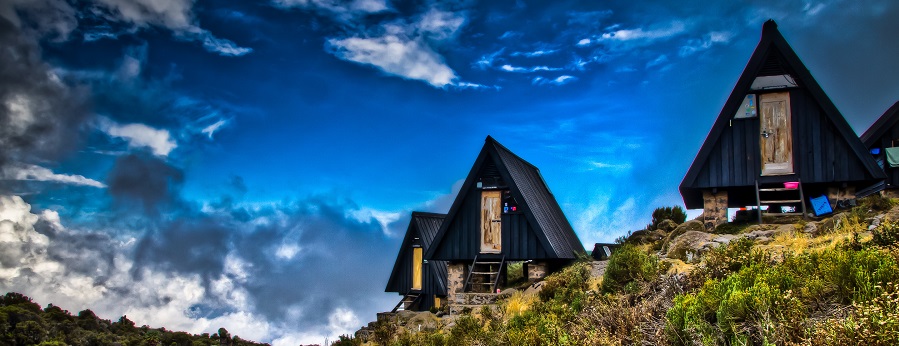
During the climb you will be staying in huts found on the route to the peak!
As for scenery, of course, the Marangu route is still breathtakingly beautiful. However, it is considered to be less scenic, as the ascent and descent travel along the same path and is sometimes crowded. The trail is well maintained due to its popularity and will have you travelling through forests or the Saddle (a high-altitude desert) before reaching the Kibo Hut.
The route itself also attracts novice hikers or trekkers who are looking to enjoy the luxury of sleeping in dormitory-style hut accommodation, and this is the only trail which offers this type of comfort.
The huts in this route are:
1. Mandara Hut
2. Horombo Hut
3. Kibo Hut
Before you start planning your trek, don’t be tricked into thinking that a solid roof over your head makes this journey any easier. In the huts, everything is communal; from the basic washrooms to the showers and the dining halls.
Aside from the added bonus of hut facilities on the trail, many hikers and trekkers opt for the Marangu route because it is considered to be the easiest route on Kilimanjaro thanks to its gentle slope and direct path. Don’t forget though, as we mentioned earlier, the short time frame adds to the difficulty.
The Marangu route can take anywhere between 5-6 days to complete. However, it is suggested to avoid the 5-day trek as the quick ascent may reduce your chances of reaching the summit.
The main itinerary difference between the Marangu 5-day and 6-day route is the additional acclimatisation day.
Previous trekking experience is highly recommended, as the days will feature 6-8 hours hiking with daily ascents of 900m to 1,000m, perhaps with the odd day ascending around 1,100m to 1,200m.
You will need complete confidence in your ability to trek for many days over difficult terrain. Extremes of altitude and weather may be encountered and a degree of physical and mental stamina will be essential to complete the hike as the days will be tiring.
The Marangu route, or the Coca-Cola route, is known to be one of the least expensive routes to complete due to the shorter time allocated to reach the summit. Yet it also shares the lowest success rates, as hikers tend to rush to reach the top. Skipping one additional acclimatisation day can significantly lower the average success rate of 50%.
You can climb the Marangu route year-round, but it may be wet and cold which means you should be equipped with the right waterproof gear. Consider climbing between January–March and June–October. Note that April, May and November are the wettest months.
While trekking tour operators may supply some of the gear you’ll need, there are a few non-negotiables you will need that includes waterproof gear, a headlamp, sunglasses, appropriate hiking boots, personal medication, a non-disposable water bottle and a cap or a beanie for example.
Before you start your hiking escapade to the summit of Mount Kilimanjaro, you will need to establish how to get there, and the best mode of transport to suit your itinerary or tour. Travellers flying from the UK, the US, Australia or Canada and other parts of the world have a few options to explore.
Mount Kilimanjaro welcomes hikers of all levels of fitness and ability, but if you’re planning to reach the summit, careful planning and vigorous training is vital. Consider adding extra time to your itinerary to avoid altitude sickness and to enjoy your time climbing Kilimanjaro.
Each visitor will be required to pay a fee per person, per day for the conservation fee to help manage the national park, however, most tours will cover the permits and entry fees are included in the price.
1. Machame Route. Distance: 62 km, average duration: 6-7 days, success rate: 75%-85%
2. Marangu Route. Distance: 72 km, average duration: 5-6 days, success rate: 50%
3. Lemosho Route. Distance: 70 km, average duration: 7-8 days, success rate: 65%-90%
4. Rongai Route. Distance: 73 km, average duration: 6-7 days, success rate: 65%-80%
5. Shira Plateau Route. Distance: 56 km, average duration: 7-8 days
6. Umbwe Route. Distance: 53 km, average duration: 5-6 days, success rate: 60%-70%
7. Northern Circuit Route. Distance: 98 km, average duration: 8-9 days, success rate: 95%
Marangu is one of the oldest and most popular Kilimanjaro routes. It’s sometimes called the Coca-Cola route because you stay in huts and can buy a Coke en route. The Marangu route approaches the summit from the southeast of the mountain. Overall it’s a relatively easy route, having very few steep climbs. But its acclimatisation profile is mediocre, as it doesn’t allow much time for acclimatisation. Fewer people therefore make it to the top when you look at its summit success rate compared with those of the other routes.
During your research you may have heard that the Marangu route is the cheapest, easiest and most popular route up Kilimanjaro. This is, in fact, an outdated view, and we feel quite the opposite. The Marangu route is probably one of our least favourite Kilimanjaro climb routes. Whilst offering rewarding views from the Saddle (a high-altitude desert), it’s less scenic than other Kilimanjaro routes because you ascend and descend via the same trail.
The Marangu route is the only Kilimanjaro route to offer hut accommodation. On all other routes you must camp. On the Marangu route you sleep in dormitory-like huts that provide mattresses and other basic amenities. This makes the route a popular choice for budget operators that don’t have camping equipment. We only recommend choosing this route if you really don’t want to camp.
The Marangu route is less scenic than the other Kilimanjaro routes because you ascend and descend along the same path. That said, the scenery is still very beautiful; you pass through rainforest, moorland, high-altitude desert, and an arctic zone. It’s just worth noting that other routes offer more variety in the way of scenery because their ascent and descent routes aren’t the same.
The Marangu route has a reputation for being an ‘easy’ climb, but this perception is actually misleading. Yes, it offers amenities like hut accommodation and, yes, it’s a comparatively shorter route. But it demands you ascend quickly and so many people climbing this route suffer from poor acclimatisation and don’t make it to the top. The Marangu route actually has the lowest success rate of all the seven Kilimanjaro routes. This just goes to show that you shouldn’t fall for the promise of ‘easy’!
All that being said, while we wouldn’t necessarily recommend the Marangu route, it is definitely still achievable with the right Kilimanjaro preparation, which includes an awareness of the risks. You might also like to read our trekking tips for beginners.
If you are physically fit, choose a good mountain crew to assist you in your climb, and can accept the risks, you should be able to achieve the summit via the Marangu route.
The Marangu route is one of the shortest Kilimanjaro routes, which gives it a relatively poor acclimatisation profile. Summit success is low. Whilst there are no official statistics, the average success rate across all Kilimanjaro operators for the five day route is 50%. That means your chances of reaching the summit of Kilimanjaro when using the Marangu route aren’t fantastic. (We usually recommend opting for the Lemosho route or one of the other Kilimanjaro routes with a better acclimatisation profile.)
The Marangu route is a popular choice among the seven Kilimanjaro routes because it’s seen as an easier climb, given its gradual slope and direct path. It’s therefore a busy route and can get crowded. If you want to avoid the crowds, this Kilimanjaro route is not for you.
The Marangu route is the only route to offer hut accommodation. There are 60 bunk beds at both Mandara and Kibo Huts, and 120 bunk beds at Horombo Hut. You must bring your own sleeping bags, but you’re supplied with mattresses and pillows at the various huts. Check to see if your chosen tour operator has sleeping bags you can use.
The huts themselves have communal dining halls and washrooms. The latter range in quality: you can expect running water and flushing toilets at the lower huts, and buckets of water and long drops at Kibo Hut.
The Marangu route can be completed in five to six days. We would always recommend the six-day itinerary. We find that the low success rate of the Marangu route is mainly the result of unprofessional tour operators taking people up the mountain on the short five-day itinerary. A five-day climb simply doesn’t give you enough time to acclimatise. Furthermore, climbing Kilimanjaro is not a race. Take your time and soak in the views and experience!
The Lemosho is the most beautiful Kilimanjaro route.
The Machame is the most popular Kilimanjaro route
The Marangu route only offers hut accommodation
The Rongai is the only route that approaches from the North
The Shira route Approaches from the Western side of Kilimanjaro
The Northern Circuit is the newest and longest Kilimanjaro route
The Umbwe is the shortest, steepest and hardest Kilimanjaro route
Click on the image for an overview map of MaranguEver since tourism expanded on Kilimanjaro the Marangu Route has been the most popular trail, and with a path that takes in such glorious features as the deep rich forest of the south-eastern slopes, the flower-filled Maundi Crater and the wind-blown high-altitude desert of the Saddle, it’s not surprising. The Marangu Trail is also the only trail where you sleep in huts rather than under canvas. Do not, however, be misled into thinking this route is easy – indeed, many people fail to reach the summit on this route because they have failed to acclimatize properly. For this reason, we have included a ‘rest’ day in our itinerary, where we spend two nights at Horombo Huts in order to increase our chances of acclimatizing properly – and making it to the summit safely!
Known by many as the “Coca-cola route”, Marangu is by far the most popular route for climbing Mount Kilimanjaro. This is the shortest route and can be climbed in just 5 days, but extending this trekking to 6 days does greatly increase your chance of summiting successfully. The main difference compared to the other routes is the hut accommodations rather than the mobile tents. Our experienced team will answer any of your queries as they arise.
The Marangu Route is perceived as an easy Kilimanjaro climbing route. The Marangu Route goes via a relatively comfortable trail and has a very steady, gradual slope. This would make you believe that the Marangu Route is easy. The route is also dubbed Coca Cola Route or Tourist Route. This can give a bad impression to people who are interested in tackling the Marangu Route. It sounds easy, right?
In fact, the Marangu Route is fairly difficult. It is not easy and it’s definitely not for tourists. Most people who take on the Marangu Route do so because it allows them to climb Kilimanjaro in five days. Unlike on other routes like the Machame Route or the Lemosho Route, the Marangu Route has a low success rate. Only about a third of all climbers make it to Uhuru Peak.
Nonetheless, the Marangu Route is a Kilimanjaro classic. It is one of the oldest routes and, let’s not forget that, the Marangu Route comes with huts. If you don’t like sleeping in tents, then the Marangu Route is your choice.
The Marangu Route has a reputation problem going on. It is known as the Tourist Route or the Coca Cola Route and the reason for that is that it is an easy route. But because of poor acclimatization it is not an easy route at all. In fact, it is quite difficult. Why then is it called the Tourist Route or the Coca Cola Route?
In the huts that can you find on the Marangu Route they sell that particular beverage. The fact that it has huts, is a drawcard for tourists. Where there are huts, there must be some comfort right? That is one of the reasons. The other reason why it is called the Tourist Route is that it is quite the crowded one. Although the popularity of the Marangu Route is shrinking, it still attracts a lot of climbers who want to make it to Uhuru Peak.
The Marangu Route has a total distance of 73 kilometers or 45 miles from gate to gate.
Day-to-day distance on a 6-day climb:
Day 1: 8 km / 5 mi
Day 2: 12 km / 7.5mi
Day 3: Rest day
Day 4: 9 km / 5.5 mi
Day 5: 6 km / 4 mi up / 15 km / 9 mi down
Day 6: 20 km / 12.5 mi
If you are not much of a camper and you like to have a solid roof over your head, the Marangu Route is your Kilimanjaro climbing route. After all, it is on this route that you get to stay in huts. You will find the huts spread out in camps along the route. There will be your checkpoints where you will get to spend the night. You will spend the night at the Mandara Huts, the Horombo Huts and the Kibo Huts.
The huts are pretty basic. They are communal, which means that you will sleep in bunk beds dormitory style. The sanitary facilities will make you go back to basics as well. Some of the camps have running spring water that also supplies toilets, others come with long drop toilets. Expect to share a hut with 6 to 8 other people.
What is it with people and mountains? According to Friedrich Nietzsche, ‘he who climbs upon the highest mountains laughs at all tragedies, whether real or imagined’. Fair enough. But is this really a rationale, or just a sign of high-altitude deliria? When asked why he wanted to climb Everest, George Mallory famously replied: ‘Because it’s there.’ Unfortunately for Mallory, so too would his corpse soon be. (Nietzsche, a keen mountaineer himself, would have probably found this hilarious.) ‘Apparently, more people have died climbing Kilimanjaro than Everest’, I tell my mother as she bids us (her husband and three children) farewell at the airport. This trip should be a laugh-fest.
In truth, the death rate on Kilimanjaro pales in comparison to the sheer number of climbers who set out to scale the mountain each year (some 25,000 in 2010). As big mountains go, ‘Kili’ is pretty user-friendly; there are several well-trodden routes, a host of trekking companies and comfortable campsites with hot running water and tea- and coffee-making facilities. And yet, at the best part of 6,000m, Africa’s highest peak is not to be laughed at (though Nietzsche probably would…).
Though the climbing is non-technical - unless of course you’re one of porters (standard issue: two per person) balancing a week’s worth of food and fuel on your head – the success rate on the main routes is low, as little as 30% on the most popular approach. The cause is rarely physical exertion – the porters shoulder that burden - but rather the Russian roulette of altitude sickness, the symptoms of which are often described as being akin to the worst hangover imaginable. A sobering thought. I’m fairly apprehensive, then, about my family’s chances of reaching Uhuru Peak. Though all of our party are in fairly good shape, that 30% success rate means that, statistically speaking, only one of us (or one and a bit – queue chortles from Nietzsche) will make it to the summit. “It’s the journey that’s important, not the destination”, we remind ourselves (30% in jest, 70% in justification).
And quite some journey it is. All the pre-trek chat about altitude sickness, sub-zero temperatures and blisters the size of sheep’s bladders had obscured the fact that this was, after all, a five-day hike through a spectacular national park. The mountain itself is a sky island, its various ecosystems having been severed from the mainland and cast adrift in a sea of cloud. Indeed, as one of the world’s tallest ‘true’ mountains, Kilimanjaro comprises five distinct ecological zones, each home to countless endemic and relict species of flora and fauna. So immense is this upturned ark that the migratory birds inhabiting its lower levels need only move a few kilometres up the mountain come change of season. Conversely, a creature at home on one part of the mountain may struggle to survive just a short distance up (as many a climber has discovered).
Our trek up Kilimanjaro follows the Marangu (a.k.a. Coca-Cola) route. (Why Coca-Cola? Because it is cheap and popular but should probably carry a health warning.) The five- or six-day climb traverses the eastern flank of the mountain, with each leg covering approximately 1,000 vertical metres and coinciding with a different ecological zone. Thus, we ascend first through the mountain’s forested skirt, its dark folds hemmed by silver streams and gleaming with floral sequins. At around 3,000 metres the trail unfurls across open moorland and the twin peaks, Uhuru and Mwenzi, make themselves known in the distance. On occasion, there appears on the horizon a great maelstrom of dust and clamour, which, as it rolls nearer, reveals itself to be the mountain rescue team: four men wheeling an improvised stretcher that looks like a door glued to unicycle. The first time we encounter this onrushing omen we’re understandably fretful, but we’re soon reassured by the good cheer of the stretcher-bearers, who sing and joke as they hurtle down the mountain with their unconscious quarry. (Clearly fans of a certain German philosopher…) Other returnees are slightly more vertical though often no less broken; ‘are they the ones that made it’, we wonder aloud, ‘or the ones that ruined themselves trying?’
Day three is an alpine desert, literally and mentally. Features on the trail, targeted as milestones, appear, like the charging knights in that Monty Python scene, perennially out of reach, while further still the mile-proud peak taunts us with its indifference. By the time one reaches Kibo Hut (4,730m), the prospect of tomorrow’s climb seems about as appetising as the cucumber soup we’re served attomorrow’s climb seems about as appetising as the cucumber soup we’re served at dinner, not least because tomorrow’s climb starts in just six hours, at 12 a.m. sharp. Between then and now, one is required to negotiate a string of ultra-banal tasks – eating, resting, visiting the little boy’s hut – which, on account of a lack of oxygen and an overabundance of underwear, are rendered epic undertakings in themselves. Thus, it is with a curious mix of abject fatigue and raw adrenalin that we set off through the midnight dark to begin our summit attempt.
Now this may hard to believe, but the six-and-a-half hours it took to reach Uhuru seemed to fly by. Needless to say, it was not in any way fun, but nor was it wholly unpleasant. My main sensation, in fact, was tedium, a pure, crystalline boredom that in time became so acute it induced a warm and fudgey hypnosis. For the entirety of the ascent, your sensory stimulation is limited to a) the feeling of listless plodding, b) the sound of heavy breathing and c) the sight (lit by head-torch) of the back of your guide’s boots. If you’re lucky, you might have d) the taste of impending vomit and e) the smell of dinner revisited (altitude plays havoc with one’s gas levels) to add to the equation, though these are but momentary distractions. The only real respite is the summit itself…
As the sun prizes open the firmament, we are greeted with a sight of untold majesty: ok, it’s still the back of our guide’s boots, but now the boots in question are rounding the crater rim, with ice fields to one side and the parched mouth of the volcano to the other. Shadows shorten, and in no time at all (well, another mind-numbing hour) we’re standing on the rooftop of Africa, surveying the continent, laughing at tragedies, queuing for a photo with the sign. And no sooner has the shutter clicked than we’re off again – this is no place for loitering – surfing down the mountain on a tide of scree. This is pretty much the story for the next two days. Our route down is the same as the one we took up, which means no new scenery but lots of fun to be had with those en route to the top. (The words ‘good luck’, we discover, uttered with a knowing smile, can fill people with both bonhomie and utter foreboding.) Gradually, life returns to the mountain, and with it civilisation. At this point, our interest in the latter extends no further than showers, beer and Internet, which we seek out (in this order) once back on flat land.
A week later, the clouds clear momentarily and the mountain graces us with a view from the plateau. A curious feeling consumes us, one probably common to all ‘real’ mountaineers; it’s nothing more profound than ‘I was there’, and strangely, there’s nothing more exhilarating.
Epilogue
In the spirit of broadcasting standards, I should point out that other Kili trekking routes are available. While Marangu is doubtless an option if time and money are very limited, we always prefer to recommend one of the longer routes (Machame, say, or Lemosho), which promise a far greater chance of reaching the summit. Moreover, unlike the Marangu, these other treks don’t jag back on themselves, which means a greater variety of scenery and far fewer mid-mountain traffic jams.
Marangu route is well-known as the easiest route up Kilimanjaro however we consider from our experience, there are no easy routes. It doesn’t matter which way you take, all climbs are tough and should not be taken as a walk in the park.
A nice part of the climb on the Marangu route is that all accommodation is in huts – this is a much softer and warmer option than sleeping in tents which is the only option you will have on the other routes. You will sleep in bunk beds with fairly comfortable mattresses. Other creature comforts such as mineral water, soft drinks, chocolates and beers are sold at all the camps on this route. All huts have solar power.
Although it is possible to finish Marangu Route in 5 days by any normal fit person – we recommend taking the 6 day route so that you can acclimatize properly on fourth day. By taking time you will increase your chances of reaching the summit by up to 75%. It would be unwise to think that everyone makes the summit because this is one of the easier routes – in fact this route has the highest rate of failure. Unfortunately hikers take it to easy.
Under the leadership of your guide, all your equipment and supplies are carried for you by a team of porters and a cook will prepare all your meals. All you will need to carry will be your day pack items such as drinking water, your lunch pack and some additional clothing.